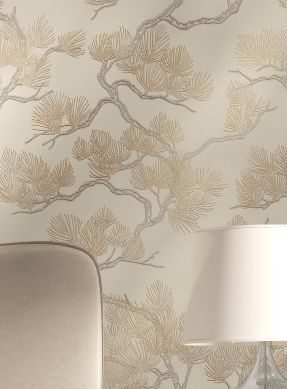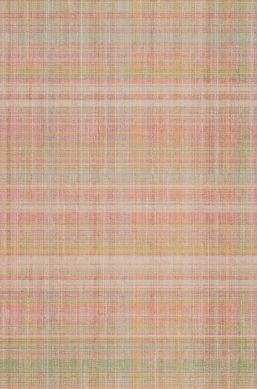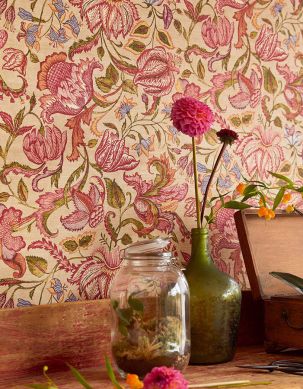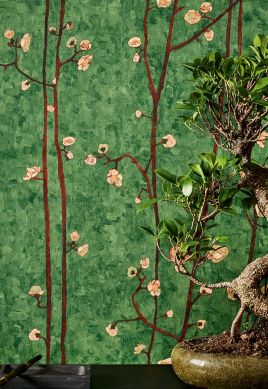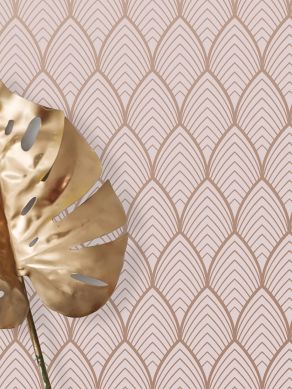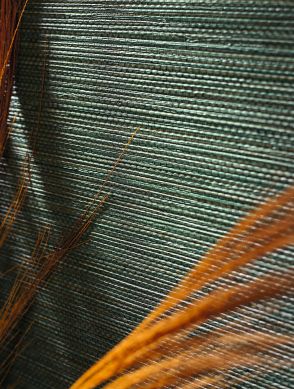Vinyl Wallpaper
Vinyl wallpaper: The Guide
In the 1970s, wallpaper manufacturers looked for a moisture-resistant alternative to open-pore paper-based wallpaper and came up with vinyl wallpaper. The washable, robust wallpaper with a plastic surface began its triumphal march around the globe. It is often used in rooms with heavy wear and tear as well as with high moisture development. In addition to these advantages, there is a plethora of choice of surface finishes, patterns, colours and effects.
Table of Contents
- What is vinyl wallpaper?
- Which processes are used to produce vinyl wallpaper?
- What are the special characteristics of vinyl wallpaper?
- Which paste should be used to hang vinyl wallpaper professionally?
- How can vinyl wallpaper be cleaned?
- How is vinyl wallpaper removed and disposed of in an environmentally friendly way?
- Why are vinyl wallpapers especially suitable for the kitchen?
- Can vinyl wallpaper replace tiles in the bathroom?
- Which areas are best suited to vinyl wallpaper?
- Can vinyl wallpaper be harmful to our health?
- What kind of surfaces can vinyl wallpaper have?
- Which wallpaper manufacturers specialise in vinyl wallpaper?
- Our tips: Design ideas with vinyl wallpaper
What is vinyl wallpaper?
Each vinyl wallpaper consists of a compound of vinyl and a carrier material. This can be either paper or non-woven material onto which the PVC coating is applied. Vinyl wallpaper is an invention from the 1970s.
Invention of the 1970s
Vinyl wallpaper was developed in the 1970s as a waterproof alternative to classic paper-based wallpapers. There was a clear demand for a solution that would allow easy cleaning of stains, especially for wet areas and rooms with heavy use. Since then, vinyl wallpaper has become almost indispensable for modern wall design concepts.
Paper or non-woven carrier material
The carrier layer of vinyl wallpaper can be made of paper or non-woven materials. Thanks to clever material compositions, non-woven material is stronger than paper, easier to apply and can also be removed dry without leaving any traces behind. For bathrooms, only vinyl wallpaper with a non-woven carrier layer should be used as paper is unsuitable.
Coating made of PVC
Vinyl wallpapers get their name from their polyvinyl chloride surface coating. PVC is a thermoplastic polymer that is chemically extracted from the monomer vinyl chloride. Besides polyethylene and polypropylene, PVC belongs to the group of thermoplastics. In addition to PVC, the surfaces of plastic-coated wallpapers can be made of other synthetic materials from this main group, such as polymethyl methacrylate, polyvinyl fluoride or ethylene-vinyl acetate copolymers.
Which processes are used to produce vinyl wallpaper?
There are three common processes for the production of vinyl wallpaper. These are: a sprayed-on acrylic layer, a solid PVC layer laminated onto the carrier material or pastes foamed under heat.
Sprayed on in liquid form as an acrylic layer
A liquid acrylic layer is sprayed onto the respective carrier material, free from blowing agents. The wallpaper dyes (inks) are then printed on and fuse with the vinyl when heated. The inks consist of fine pigment particles. The wallpaper must then be dried thoroughly.
A solid PVC layer laminated onto the carrier material
A solid PVC layer is firmly fused with the respective carrier material by lamination. This is done in large production machines via a process which combines pressure and heat. The laminated vinyl surfaces are often given special surface structures (e.g. embossing) in further processing steps.
Foamed under heat
So-called foamed vinyl (special vinyl paste) is applied to the respective carrier material by screen printing. Gaseous chemical substances are produced in an evaporation process at very high temperatures, which in turn interact with the vinyl to form pores that cause the vinyl to foam.
What are the special characteristics of vinyl wallpaper?
Vinyl wallpaper is characterised by a number of positive characteristics which provide advantages in terms of private as well as commercial and public use. These models are water-resistant, flame-retardant (low flammability), hard-wearing and can be painted over.
Water-resistant
Vinyl wallpaper does not absorb moisture. It is washable, waterproof and can be cleaned with a damp cloth or sponge. Depending on specific cleaning characteristics, even special cleaning agents and more intensive manual cleaning are not a problem. Vinyl wallpapers are perfectly suitable for wet rooms such as kitchens and bathrooms.
Low flammability
Vinyl wallpapers boast low flammability characteristics in case of fire and belong to fire-resistant furnishings, which is of particular importance in public and commercial spaces. Products with low flammability have a special finish which means they do not immediately catch fire. They are also self-extinguishing.
Robust
The plastic coating makes vinyl wallpapers extremely robust and resistant to damage. They remain dimensionally stable and retain their shape. Little maintenance is required, which can be done a little more forcefully and with appropriate agents. With vinyl surfaces, minor damages are not particularly obvious.
Can be painted over
Some vinyl wallpapers can be painted over. These mostly have foamed surface structures. All other PVC wallpapers are usually completely water-repellent, which is why water-soluble paints just roll off the plastic surface.
Cannot be wallpapered over
Vinyl wallpaper cannot be wallpapered over because conventional paper-based and non-woven wallpaper paste does not stick to the water-repellent surface. Dispersion adhesive can be an option, but is unsuitable for entire walls. Smaller decorative elements such as borders made of vinyl can, however, be applied to vinyl wallpaper (plastic on plastic).
Which paste should be used to hang vinyl wallpaper professionally?
The carrier material of a vinyl wallpaper determines which paste can be used and how the wallpaper should be put up. The relevant distinction is whether the vinyl wallpaper has a paper or a non-woven carrier.
Vinyl wallpaper on paper carrier
For these wallpaper types, normal paper wallpaper paste is used. For heavy and thick vinyl wallpapers, a special paste with increased adhesive strength is mixed according to the information on the packaging. The length or strip of wallpaper is to be pasted on the back side generously and evenly, preferably on a trestle table. Afterwards the length must be left to soak; the soaking time is specified on the paste package.
Vinyl wallpaper on non-woven carrier
For vinyl wallpaper with a non-woven carrier, a paste for non-woven wallpaper is needed. This is either ready-mixed or available as a powder to be mixed with water. In damp rooms such as kitchens or bathrooms, a small amount of dispersion glue can be added for better adhesion. Instead of the wallpaper strips, the wall is pasted directly. Soaking times are not necessary.
How can vinyl wallpaper be cleaned?
The plastic surface prevents moisture from penetrating into the vinyl wallpaper, making it washable. The cleanability is divided into washable, super-washable, scrubbable and highly scrubbable.
Washable
Washable wallpapers have a simple plastic coating. Light soiling and water-soluble stains can be gently removed with a damp cloth and soapy water. Grease, oil and stains containing solvents cannot be removed. Abrasive cleaners must not be used on washable vinyl wallpapers.
Super-washable
Super-washable wallpapers are sealed even more densely than washable wallpapers, which allows the removal of more serious stains. Even some greasy stains can be washed off with soapy water and a sponge while they are still fresh. Careful rubbing is also an option.
Scrubbable
Scrubbable vinyl wallpapers have a robust PVC layer with the colours firmly embedded in the material. Greasy and stubborn stains and dirt can be removed carefully with a damp sponge or soft brush and mild cleaning or scouring agent.
Highly scrubbable
The highest level of cleanability allows for more intensive surface cleaning than with all other vinyl wallpapers, because the PVC layer is even more robust. This makes it possible to remove various types of dirt as well as fresh, greasy stains with a soft brush and cleaning or scouring agents. In addition, more pressure can be applied to the wallpaper.
How is vinyl wallpaper removed and disposed of in an environmentally friendly way?
Vinyl wallpapers can be stripped in a dry or wet state, or the top layer can be removed in a dry state, depending on the carrier material. The best way to dispose of it in an environmentally friendly way is via the usual household waste service or at the local recycling yard.
Dry strippable without residue
Vinyl wallpaper with a non-woven carrier can be taken off in complete lengths, without any preparation, dry and without leaving any residue on the wall. The length of wallpaper is grasped with the fingers at the top side seams and removed from top to bottom. Generally speaking, this should be possible without any problems, otherwise a spatula will help to remove the wallpaper.
Dry peelable (separating the surface layer from the carrier layer)
For vinyl wallpapers with paper carrier layers which are labelled as "dry peelable", the upper vinyl layer is first removed in one go. This is usually done in whole lengths or very large pieces. What remains is the paper layer, which either stays on the wall as waste or can be removed (after soaking) with a spatula.
Wet Removable
For vinyl wallpapers with a paper carrier layer which can only be removed after soaking, the plastic surface must be made water-permeable. This is done with tools such as a spiked roller. The wallpaper is treated with a sponge, brush or spraying bottle as well as a mixture of washing-up liquid and warm water. After about 15 minutes, it should be soaked through and can be removed with a spatula.
Domestic waste or recycling centre
Wallpaper with a plastic surface is disposed of in the residual waste bin. For larger quantities visit the local recycling centre. In both cases, old vinyl wallpaper and cut-offs end up in the incinerator. The heat generated during the incineration process is converted into energy and reused several times, resulting in an improved environmental balance.
Why are vinyl wallpapers especially suitable for the kitchen?
Wallpapers with vinyl surfaces are particularly popular and versatile in kitchens. They can serve as an unconventional back wall or imitation tile backsplash as grease is easy to remove.
Grease stains are easy to remove
Fresh grease stains can easily be removed from super-washable, scrubbable and super-scrubbable vinyl wallpapers, which means they are simply perfect for use in the kitchen. Vinyl wallpaper is also recommended because the coated surface is very robust. Even the craziest cooking experiments leave no lasting marks on the walls.
Kitchen back wall
The area above the worktop comes into daily contact with liquids and all kinds of substances of every conceivable consistency. Since kitchen back panels made of acrylic or other dirt-repellent materials are very expensive, robust vinyl wallpapers in a variety of patterns, motifs and colours are a great alternative. This provides enormous flexibility in terms of design options.
Tile motifs
The classic backsplash which is intended to protect walls from rapid, persistent soiling due to grease, stains and liquids is still an important feature. Vinyl tile-motif wallpaper fulfils its purpose just like real tiles. It provides visual accents and the design can swiftly be adapted to fashion trends, not to mention the infinite choice of designs.
Can vinyl wallpaper replace tiles in the bathroom?
Modern vinyl wallpaper can be used in the bathroom as an alternative to tiles. The biggest advantage is the waterproof surface, although it is not recommended to put them up in the shower.
Use as tile replacement
Today, bathrooms are no longer tiled across the entire surface of the wall. For a new bathroom or a renovation project, it is sufficient to tile splash-water areas such as the space around the sink, the toilet, urinal, shower and bathtub sparingly and according to requirements. The rest of the walls can be covered with moisture-repellent vinyl wallpaper that is easy to clean.
In the shower
In the shower or around the bathtub or sink, not only pure water is used. The shampoos, soaps and shower gels which are used can contain chemical substances that are harmful to the plastic surface. The use of vinyl wallpaper is therefore not recommended in those areas.
Waterproof bathing-related motifs
Vinyl wallpapers come in a plethora of patterns and motifs. Waterproof motifs covering a variety of themes such as the Caribbean, mermaids or underwater worlds create an authentic atmosphere which would not be possible with tiles. Anyone can create their own personal dream bathing paradise.
Which areas are best suited to vinyl wallpaper?
Walls in rooms that are subject to heavy use benefit from robust vinyl wallpaper types because they can be wiped clean with a damp cloth. Vinyl wallpaper is particularly suitable for hallways, stairways, hotels and restaurants or even caravans.
Hallways
Hardly any other area of a house or flat is as heavily used as the hallway. Constantly re-papering is obviously no solution. With vinyl wallpaper models, the entrance area can be decorated simply and effectively with pattern motifs that charmingly convey the desired first impression. Stains caused by shoes or dirty hands touching the walls can simply be cleaned with a damp cloth.
Stairways
Walls in stairways tend to get dirty quite quickly because there is a constant stream of people passing through. In addition, moving furniture or bulky objects leaves unsightly traces every now and then. Those who know how complex and difficult it can be to wallpaper staircases frequently choose a robust and washable vinyl design wallpaper.
Hotels and restaurants
In order to keep the cleaning and renovation efforts in the hotel and restaurant industry as low as possible and still create an atmospheric ambience, vinyl wallpapers have proven their worth. They can take a lot of wear and tear and can be cleaned according to their cleaning characteristics. The synthetic surfaces also make walls in public buildings very hygienic.
Caravan
In confined spaces like caravans and motor homes, the wall coverings must be robust and hard-wearing. Vinyl wallpaper is an excellent choice here, especially for the cooking area. These models are easy-care, robust and imitate natural materials such as wood or leather.
Can vinyl wallpaper be harmful to our health?
It always depends on the specific manufacturing process. The focus is on hazardous pollutants such as plasticisers, volatile organic compounds, carcinogens and toxic pastes. But breathability also plays an important role.
Plasticisers
The term "plasticisers" refers to various substances that make plastic soft and flexible. Some of these substances are considered problematic because they enter the organism through the skin or mucous membrane. PVC can contain softeners that are released into the air in the room. If the wallpaper surface consists of environmentally neutral foam, it guarantees that there are no health risks.
Non-breathable
Since the surface of vinyl wallpaper is sealed, it cannot absorb moisture from the air in the room. It literally rolls off it. Rooms should therefore be ventilated regularly and frequently. Especially in wet rooms, the moisture must be able to dry off quickly. If moisture gets behind the wallpaper due to damages or open seams, there is a risk of mould growth.
Avoiding volatile organic compounds
When solvent-containing products are used, volatile organic compounds, e.g. hydrocarbons, organic acids and alcohol, are released into the ambient air by evaporation. They can cause health issues such as dizziness and headaches. Since 1980, certain substances such as organic dyeing accelerators or azo dyes have been banned, while strict limits apply to others.
Free from carcinogens and toxic pastes
A carcinogen is a substance or organism that can cause cancer or promote its development. Toxic pastes have a detrimental effect on the human organism. In modern wallpaper production, strict care is taken to avoid these substances and products, and as a result there are no toxicity problems today.
What kind of surfaces can vinyl wallpaper have?
The surface texture of vinyl wallpapers is extremely varied. Surfaces can be smooth and flat, textured and structured, embossed and with reliefs.
Smooth and flat
If the carrier layer of a vinyl wallpaper is laminated with a plastic foil, it is called "compact vinyl wallpaper". The surface is smooth and flat, making it particularly suitable for printing. The smooth surface makes the wallpaper somewhat more sensitive to impact, which is why it is not particularly well suited for children's rooms or public spaces.
Structured and textured
Foaming vinyl creates wallpaper surfaces with fine structures and textures. Due to the interaction with light and shade, these foam vinyl wallpapers or textured vinyl wallpapers have a spatial effect and boast a special tactile feel. When imitating natural materials such as wood or stone, foamed vinyl wallpapers can barely be distinguished from the original.
Embossed and with relief
Embossing processes such as hot stamping give the vinyl surface three-dimensional structures with a relief-like effect. Clearly perceptible, three-dimensional ornaments and reliefs can be created. Delicate details such as blossoms, leaf shapes, grasses or even geometric shapes are highlighted and emphasised. The depth effect provides a very lively, deceptively real look. Examples include satin wallpapers with an elegant silky shimmer or leather-look wallpapers.
Which wallpaper manufacturers specialise in vinyl wallpaper?
When it comes to high-quality, environmentally friendly and health-compatible vinyl wallpapers, four manufacturers have particularly distinguished themselves on the global market. Vescom, BN International, Grandeco and Sirpi produce their wallpapers with obvious passion and know-how.
Vescom
Based in the Dutch town of Deurne, Vescom is one of the most renowned international manufacturers of high-quality vinyl wall coverings for the contract market. Their extensive wallpaper collection meets the highest fire protection requirements and is specifically designed for heavy-duty use in offices, hotels, healthcare, education and leisure facilities.
BN International
BN International is a Dutch company based in Huizen which was founded in 1926 and initially produced vinyl flooring. In the 1990s, the focus shifted to wall décor, specifically exquisite vinyl wallpapers which adhere to strict ecological guidelines. Exceedingly clever material structures of wood, stone, tiles and fabric are their forte.
Grandeco
Renowned wallpaper manufacturer Grandeco was founded in 1978 under the name Ideco in Tielt, Belgium, a former centre of the textile industry in Flanders. Today, Grandeco is one of the world's leading producers of vinyl wallpapers. The range includes wallpapers to suit every taste and pattern motifs that invite you to relax, dream or simply show your extravagant side.
Sirpi
Classic Italian culture with a touch of Venetian noblesse, refined modernity and the magic of the mysterious characterise the vinyl wallpapers of Italian manufacturer Sirpi, which meets the highest wallpaper demands. Stripes, baroque elements, impressive landscapes, unconventional geometry and fine textures such as velvet or silk determine their exquisite wallpaper designs.
Our tips: Design ideas with vinyl wallpaper
- Versace wallpapers - glamorous neo-baroque captured on vinyl: Magnificent neo-baroque patterns are as important as robust vinyl surfaces for this world-famous Italian designer label. The eccentric pattern compositions have an unforgettable impact on any room. Excellent cleanability characteristics ensure that the wallpaper models maintain their radiant beauty.
- Antique tiles reflect history and create a fantastic atmosphere: Delft tiles, Spanish Majolica tiles, Art Nouveau tiles or ancient cement tiles with rare paintings - genuine pieces of this kind are exceedingly expensive and hard to find. Vinyl wallpapers in the sought-after tile look create an authentic flair without complicated installation.
- Pleasure without remorse - vinyl wallpapers in the dining room or dining area: Where people eat and drink, stains cannot be avoided. Make your life easier with a robust, washable vinyl wallpaper. Available pattern motifs and colours will suit every taste.
- Create washable furniture fronts and risers with vinyl wallpaper: Most pieces of furniture are in constant use, especially their doors and drawers. The ground-breaking pattern range of vinyl wallpapers provides the perfect opportunity for waterproof, hard-wearing furniture decorations. Even the risers of stairs can be made durable and easy to clean.














